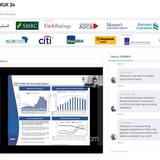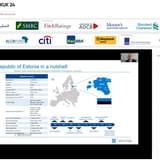The country is offering €750mn (about $848mn) of bonds maturing in January 2036 at between 130bps above midswaps, tightened from about 135bps according to data from Bloomberg. ING, Societe Generale, Citigroup, HSBC, and UniCredit helped arrange the transaction.
Shortly after the bonds were initially issued in January, Standard & Poor’s cut Poland’s credit rating from A- to BBB+, citing interference in legal and economic affairs by Poland’s right wing Law & Justice party (PiS).
The downgrade led to a 28bps yield spike on the country’s benchmark 10-year sovereign bonds and prompted a short-lived selloff that sent the zloty to four-year lows; some analysts believe this had as much to do with the unexpectedness of the downgrade as it did the general context of emerging market volatility in January.
In any event, the country’s markets continue to respond to increasing political uncertainty following recent changes to the Constitutional Court laws. The reforms passed by PiS have increased the number of judges required to make rulings on the Constitutional Tribunal and reorganised the order with which cases are heard, drawing a wide range of criticism from the country’s top judges, legal specialists, and the European Union.
Earlier this month the laws were struck down by the country’s top court as unconstitutional, a ruling the government refuses to recognise, effectively paralysing the legal system, which prompted widespread protests in Warsaw and sent yields on Polish bonds to two-week highs.
“Many of the risks that were present when we first took action are still present, arguably more-so,” says Felix Winnekens, Associate Director, Sovereign Ratings at Standard & Poor’s. “Beyond the destabilising affect the deadlock is having, it’s important to remember that most of the spending measures and reforms that will have an impact on the economy have yet to be implemented.”
Winnekens pointed to reforms that continue to be debated like lowering the mandatory retirement age, reducing income tax and the VAT, as well as larger spending initiatives that have already been announced, like the ‘Family 500+’ programme, a new child benefits package that could cost anywhere from PLN18-20bn – roughly 1% of GDP.
After constitutional deadlock set in, Moody’s placed Poland on negative watch, leading to rumours the CRA could follow S&P by downgrading the sovereign.
“In a macro sense Poland is solid – it isn’t heavily indebted and among the EM pack it’s probably one of the most economically resilient,” said Jan Dehn, Head of Emerging Market Research at Ashmore, which specialises in emerging market investments. “But for EM investors, that’s part of the problem. Simply put, they’re expensive. The country’s bonds trade above par and generally see tight spreads with low yields, which is why we don’t tend to pick them up.”
In a sense, Dehn said, the recent volatility could make the risk-reward tradeoff on Polish debt more appealing to EM investors – but only to a limited extent, if any.
“We have a very nationalistic, conservative and increasingly authoritarian government in Poland today, which has chosen to pick a number of battles with other parts of the state, including the judiciary. This is rightly becoming a concern for investors, because it distracts the government from economic issues.
“Poland has entered a less benign political phase, but from a very strong starting point. To the extent that the political noise leads to wider spreads, we might even want to pick up some bonds,” he added.









